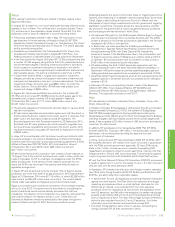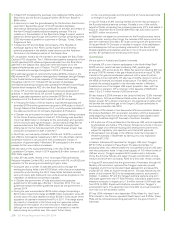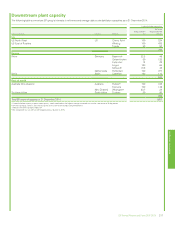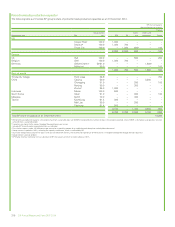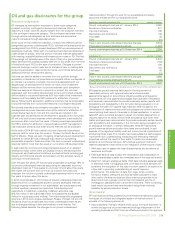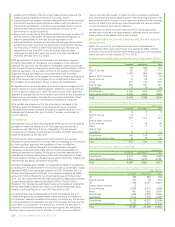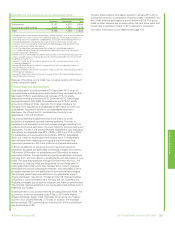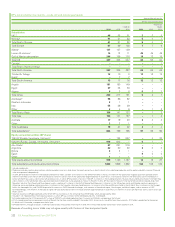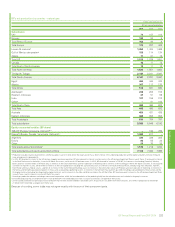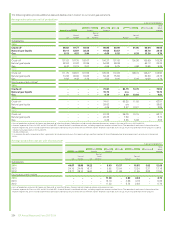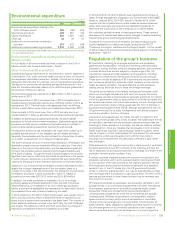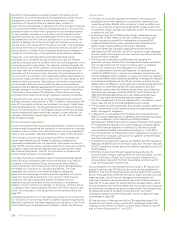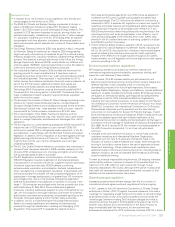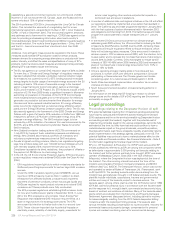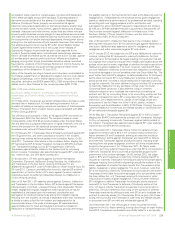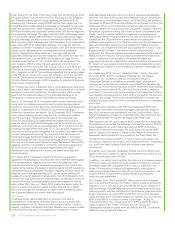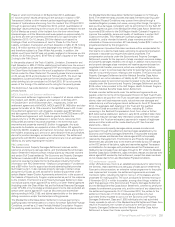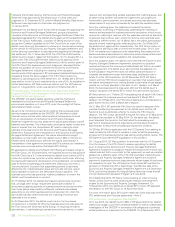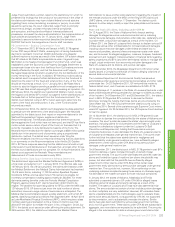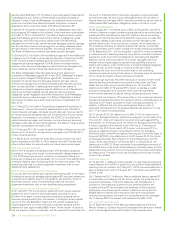BP 2014 Annual Report Download - page 229
Download and view the complete annual report
Please find page 229 of the 2014 BP annual report below. You can navigate through the pages in the report by either clicking on the pages listed below, or by using the keyword search tool below to find specific information within the annual report.
Environmental expenditure
$ million
2014 2013 2012
Environmental expenditure relating to the
Gulf of Mexico oil spill 190 (66)a919
Operating expenditure 624 657 742
Capital expenditure 590 1,091 1,207
Clean-ups 33 42 47
Additions to environmental remediation
provision 371 472 549
Additions to decommissioning provision 2,216 2,092 3,766
aThe environmental expenditure credit of $66 million in 2013 arises primarily from the write-back
of a spill response provision.
Environmental expenditure relating to the Gulf of
Mexico oil spill
For full details of all environmental activities in relation to the Gulf of
Mexico oil spill, see Financial statements – Note 2.
Other environmental expenditure
Operating and capital expenditure on the prevention, control, abatement
or elimination of air, water and solid waste pollution is often not incurred
as a separately identifiable transaction. Instead, it forms part of a larger
transaction that includes, for example, normal maintenance expenditure.
The figures for environmental operating and capital expenditure in the
table are therefore estimates, based on the definitions and guidelines of
the American Petroleum Institute.
Environmental operating expenditure of $624 million in 2014 was at a
similar level to 2013.
Capital expenditure in 2014 was lower than in 2013 principally due to
reduced levels of construction activity at our Whiting refinery in 2014 as
compared to 2013. The final major units associated with the Whiting
refinery modernization project were commissioned in December 2013.
Clean-up costs in 2014 were lower than in 2013 primarily due to an
overall reduction in clean-up activities and services required across sites.
In addition to operating and capital expenditures, we also establish
provisions for future environmental remediation. Expenditure against such
provisions normally occurs in subsequent periods and is not included in
environmental operating expenditure reported for such periods.
Provisions for environmental remediation are made when a clean-up is
probable and the amount of the obligation can be reliably estimated.
Generally, this coincides with the commitment to a formal plan of action
or, if earlier, on divestment or on closure of inactive sites.
The extent and cost of future environmental restoration, remediation and
abatement programmes are inherently difficult to estimate. They often
depend on the extent of contamination, and the associated impact and
timing of the corrective actions required, technological feasibility and
BP’s share of liability. Though the costs of future programmes could be
significant and may be material to the results of operations in the period
in which they are recognized, it is not expected that such costs will be
material to the group’s overall results of operations or financial position.
Additions to our environmental remediation provision decreased in 2014
largely due to scope reassessments of the remediation plans of a
number of our sites in the US and Canada. The charge for environmental
remediation provisions in 2014 included $13 million in respect of
provisions for new sites (2013 $13 million and 2012 $19 million).
In addition, we make provisions on installation of our oil- and gas-
producing assets and related pipelines to meet the cost of eventual
decommissioning. On installation of an oil or natural gas production
facility, a provision is established that represents the discounted value of
the expected future cost of decommissioning the asset.
In 2014 additions to the decommissioning provision were greater than in
2013, and occurred as a result of detailed reviews of expected future
costs, and to a lesser extent increases to the asset base. The majority of
these additions related to our sites in the North Sea, the Gulf of Mexico
and Angola. The additions in 2012 and 2013 were driven by changes in
estimation and detailed reviews of expected future costs.
In 2012 and 2013, the Gulf of Mexico was impacted by the Bureau of
Ocean Energy Management, Regulation and Enforcement’s (BOEMRE)
Notice to Lessees (NTL) 2010-G05, issued in October 2010, which
requires that idle infrastructure on active leases be decommissioned
earlier than previously was required and establishes guidelines to
determine the future utility of idle infrastructure on active leases.
We undertake periodic reviews of existing provisions. These reviews
take account of revised cost assumptions, changes in decommissioning
requirements and any technological developments.
Provisions for environmental remediation and decommissioning are
usually established on a discounted basis, as required by IAS 37
‘Provisions, Contingent Liabilities and Contingent Assets’. Further details
of decommissioning and environmental provisions appear in the financial
statements – Note 21.
Regulation of the group’s business
BP’s activities, including its oil and gas exploration and production,
pipelines and transportation, refining and marketing, petrochemicals
production, trading, biofuels, wind and shipping activities, are conducted
in almost 80 countries and are subject to a broad range of EU, US,
international, regional and local legislation and regulations, including
legislation that implements international conventions and protocols.
These cover virtually all aspects of BP’s activities and include matters
such as licence acquisition, production rates, royalties, environmental,
health and safety protection, fuel specifications and transportation,
trading, pricing, anti-trust, export, taxes and foreign exchange.
The terms and conditions of the leases, licences and contracts under
which our oil and gas interests are held vary from country to country.
These leases, licences and contracts are generally granted by or entered
into with a government entity or state-owned or controlled company and
are sometimes entered into with private property owners. Arrangements
with governmental or state entities usually take the form of licences or
production-sharing agreements (PSAs), although arrangements with the
US government can be by lease. Arrangements with private property
owners are usually in the form of leases.
Licences (or concessions) give the holder the right to explore for and
exploit a commercial discovery. Under a licence, the holder bears the risk
of exploration, development and production activities and provides the
financing for these operations. In principle, the licence holder is entitled
to all production, minus any royalties that are payable in kind. A licence
holder is generally required to pay production taxes or royalties, which
may be in cash or in kind. Less typically, BP may explore for and exploit
hydrocarbons under a service agreement with the host entity in
exchange for reimbursement of costs and/or a fee paid in cash rather
than production.
PSAs entered into with a government entity or state-owned or controlled
company generally require BP to provide all the financing and bear the
risk of exploration and production activities in exchange for a share of the
production remaining after royalties, if any.
In certain countries, separate licences are required for exploration and
production activities, and in some cases production licences are limited
to only a portion of the area covered by the original exploration licence.
Both exploration and production licences are generally for a specified
period of time. In the US, leases from the US government typically
remain in effect for a specified term, but may be extended beyond that
term as long as there is production in paying quantities. The term of BP’s
licences and the extent to which these licences may be renewed vary
from country to country.
BP frequently conducts its exploration and production activities in joint
arrangements*or co-ownership arrangements with other international
oil companies, state-owned or controlled companies and/or private
companies. These joint arrangements may be incorporated or
unincorporated arrangements, while the co-ownerships are typically
unincorporated. Whether incorporated or unincorporated, relevant
agreements set out each party’s level of participation or ownership
interest in the joint arrangement or co-ownership. Conventionally, all
costs, benefits, rights, obligations, liabilities and risks incurred in carrying
out joint-arrangement or co-ownership operations under a lease or
licence are shared among the joint-arrangement or co-owning parties
Additional disclosures
*Defined on page 252. BP Annual Report and Form 20-F 2014 225


